| Those who have rediscovered The Lord of the Rings through the wonderful
(if not always accurate) Peter Jackson movies probably have an image of wild New
Zealand locations whenever they think of Middle Earth.
Yet J.R.R. Tolkien’s inspiration for many of his literary locations
came not from the exotic wilderness of a foreign land, however beautiful, but
from the gentle English countryside, and the rather more sinister smoking heart
of the Industrial Revolution in and near his childhood homes in Birmingham, England.
This is a whistlestop walking tour of some inspirational places which may
still be visited by the adventurous tourist following in the footsteps of The
Fellowship of the Ring. Read this in conjunction with my biography of Tolkien
in the first article to get the most from it.
Ronald Tolkien had many childhood haunts in the Birmingham area that were
later to become the stuff of legend, and which are now as familiar to me as the
back of my own hand. Here, gentle reader, I will lead you on a quest to places
in The Shire from ‘The Fellowship of the Ring’, and to ‘The
Two Towers’ themselves (and one other!)…
In my next and final article in this present series, however, I will take
a more speculative look at The Black Country, said to have inspired Tolkien’s
ideas of the dark land of Mordor, home of the evil Lord Sauron – ‘The
Lord of the Rings’ himself!
J.R.R. Tolkien was also influenced by other places in later life, and the
horrors and joys that were to come as he matured to manhood, experienced war,
and settled into happy married and academic life. These may feature in a future
article, but first, gentle reader, we travel now to Birmingham, in the heart of
England…
Bag End, Hobbiton and The Old Forest
‘In a hole in the Ground, there lived a Hobbit’
– or, the Tolkien family’s first home in Birmingham
The tiny village of Sarehole, young Ronald Tolkien’s first home in England,
was the model for Hobbiton and The Shire in ‘The Hobbit’ and ‘The
Lord of the Rings’.
Formerly a secluded rural hamlet, surrounded by traditional English farms,
Sarehole is now a largely built-up residential suburb on the border of the Moseley
and Hall Green areas of Birmingham, and is easily reached by trains from Moor
Street Station in Birmingham City Centre, alighting at Hall Green Station and
then walking for about 15 minutes down Cole Bank Road to Sarehole Mill.
All the places shown here are within easy walking distance of each other,
but stout footware and sensible clothing is recommended for any brave traveller
who chooses to explore Moseley Bog – ‘The Old Forest’! May I
suggest then, gentle reader, that you begin your quest by walking on past Sarehole
Mill and starting, like Frodo, from Bag End, just around the corner in Wake Green
Road?
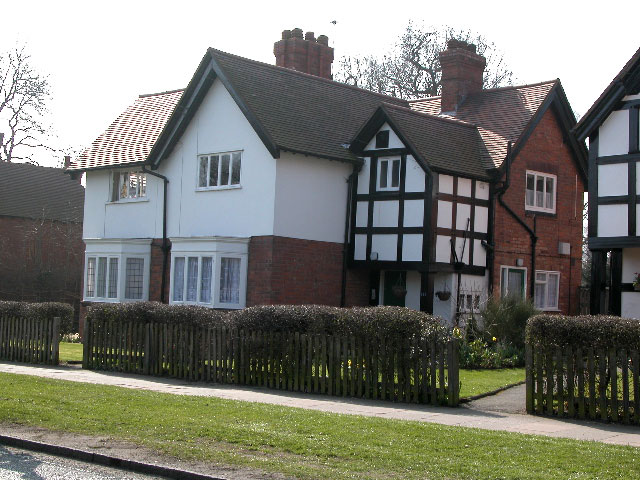
Bag End - No.264, Wake Green Road,
Moseley, Birmingham
No. 264, Wake Green Road, formerly 5, Gracewell Cottages, was the home of
the Tolkien family from 1896 until 1900. At the rear of the house is Moseley Bog
– ‘The Old Forest’ – and at the front, just across what
was then a country lane (now the busy Wake Green Road), is Sarehole Mill –
‘The Old Mill at Hobbiton’.
Together with three matching pairs of semi-detached houses, No. 264 appears
to have been built in the early 1890’s for the servants of A.H. Foster,
who lived in a larger house a short distance away.
Now a retirement home, and not open to the public (so please do not disturb
the residents), No. 264 is a fine, attractive semi-detached house of individual
style. Is this the inspiration for Bag End? It is by no means a hole in a hillside,
but is certainly a very cosy, comfortable home, ideal for a Hobbit.
Our next stop is Sarehole Mill, now fine museum, which we will explore for
a while before entering the mysterious and beautiful Moseley Bog. On the opposite
side of Wake Green Road from No. 264 is another boggy area of woodland surrounding
the pond of Sarehole Mill. Step lively, but cautiously, young Hobbit, across the
road, and when you arrive here, you are at the heart of Hobbiton, and surrounded
by fellow Hobbits, at least in spirit.
The Old Mill at Hobbiton
- or, Sarehole Mill
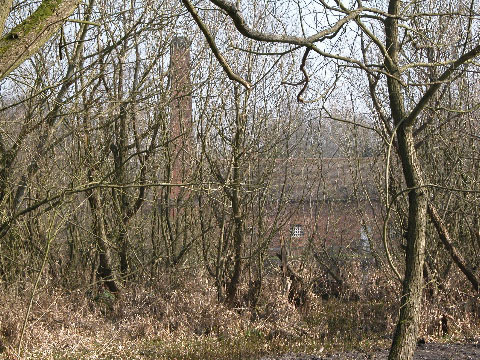
The rear of Sarehole Mill from Wake
Green Road, Moseley
You can reach the Mill safely and in Hobbit-style (avoiding the dangers of
the road!) by entering what is now a playing field through a gate in Wake Green
Road, and then walking alongside the Mill Pond on your right, which can be glimpsed
through fencing and trees. The pond receives its water from nearby Coldbath Brook,
which travels beneath the road from Moseley Bog until it enters the pond.
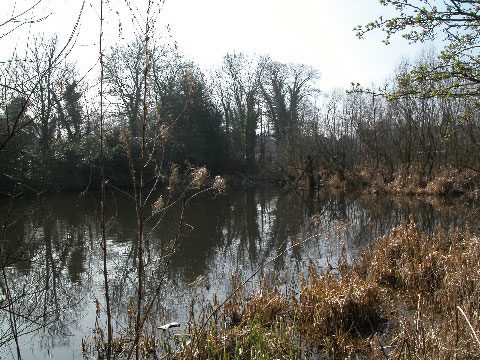
The Old Mill Pond
We know that Tolkien played in and around the Mill as a child. It is said
that whenever the miller’s son (who came to be known by young Ronald Tolkien
as ‘the White Ogre’, from his floury appearance!) caught him and his
brother, he would chase them away, to teach them not to trespass in what was really
quite a dangerous area for children. There was also a local farmer, who beat the
boys when he found them playing in his crops, whom they called ‘the Black
Ogre’ - perhaps he inspired Farmer Maggot?
Walking along and staying on the right, you will cross a small bridge over
the Coldbath brook as it exits from the Mill. Here you may walk across the small
car park (accessible by cars from Cole Bank Road), and enter Sarehole Mill via
the visitor centre, where you will find displays, maps and leaflets of great interest
to curious Hobbits. Admission to the Mill is free, but donations are welcome.
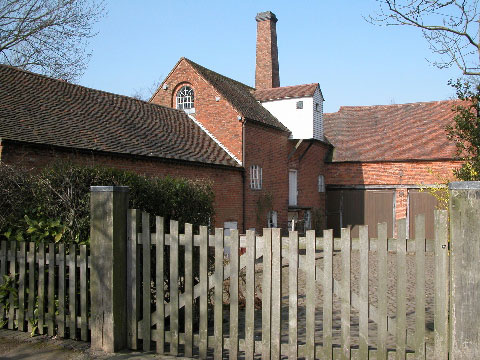
Former entrance to Sarehole Mill
Once watermills were a very common sight along Birmingham's rivers. It is
estimated that in the 18th century there were over fifty in the area. However,
of all Birmingham's watermills, only Sarehole Mill and Newhall Mill (in Sutton
Coldfield) survive as standing buildings with working water-driven machinery.
There has been a mill at Sarehole for over 450 years. The first known records
date from 1542 when a man named John Bedell was allowed to build a corn mill on
this site. Corn was ground at Sarehole Mill until 1919, and this is still done
occasionally for demonstrations and special events.
However, watermills were not only used for agricultural work; waterpower was
used in Birmingham's industrial workshops until the late 1800s, and Matthew Boulton,
leading light of the Lunar Society, is reputed to have used the mill at Sarehole
for rolling metal in the 18th century before building his Manufactory at Soho
in Handsworth.
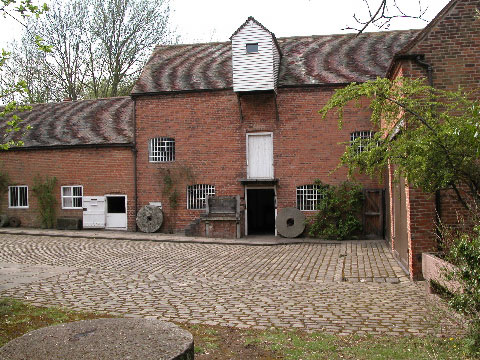
The courtyard of Sarehole Mill
The main building on site is L-shaped with a separate bakehouse and stable
block situated to the east. The buildings have been taken down and rebuilt several
times. Current buildings date from the early 19th century.
Sarehole Mill was restored and opened as a museum by Birmingham City Council
in the 1960's, and J.R.R. Tolkien contributed to its restoration. Visitors to
Sarehole Mill today will see an attractive group of buildings, including a bakehouse,
a metal workshop, a granary and the mill itself, all arranged around a cobbled
courtyard. The ground floor contains displays, an education room and the waterwheels
and associated gearing. Due to the Mill’s construction, access to the upper
floors is by steep stairs only.
Annually, The Tolkien Society jointly organises, with Birmingham City Council,
a grand Tolkien Weekend at the Mill, which is great fun. See: www.tolkiensociety.org
In any event, you will want to tarry a while in Sarehole Mill, for there is
much to see, which takes around an hour. Be careful you do not disturb the White
Ogre, though!

The North Waterwheel, used for grinding
flour
The power to turn the mill’s wheel comes from the pond. Dropping down
from the mill pond through an inlet, the water drives the wheel around, thereby
turning the cogs within via a shaft, and grinding whatever the mill needs to process,
normally corn.
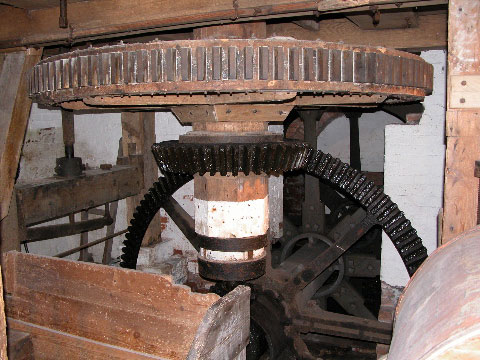
North wheel gearing
The gearing from the North Wheel transfers the power of the water upstairs
to grind the flour. There is also a smaller south wheel, not normally used these
days.
Much of the rest of the operational machinery is upstairs, and it is worth
noting that there is no wheelchair access to the upper floors, and stairs are
fairly steep, but the climb is worthwhile as there is much to see.
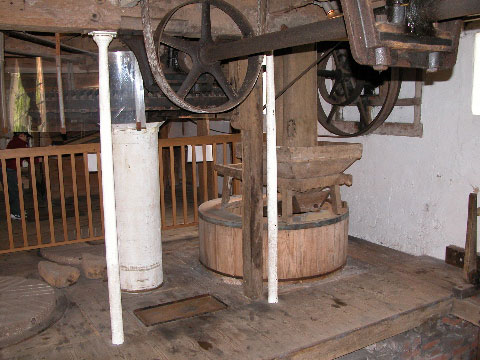
The grindstones work in pairs
Corn pours from grain bins in the attic, into the hopper, then into the centre
of the upper grindstone and is gradually transferred between upper and lower stones,
ground into flour, and is carried out by the motion of the wheels and collected.

The Attic
The attic of the mill contains the grain bins, flour bins and numerous items
of lifting gear for bringing sacks of grain and flour up to the attic.
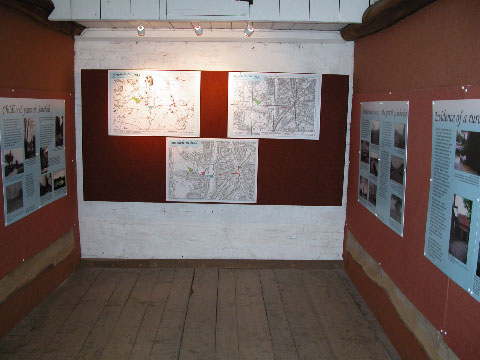
The Tolkien display room
On the way down again to exit the building, is a room specially dedicated
to a display on Tolkien and old maps of the area
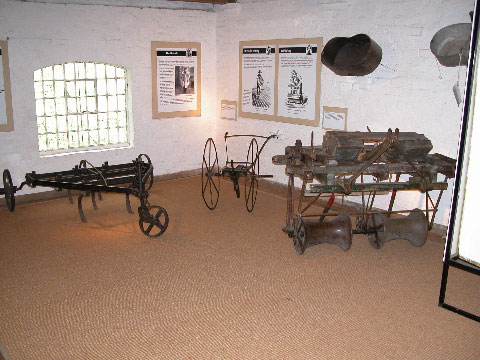
Farming implements
Another room contains a display of numerous farming implements, too numerous
to show here.
There is far too much to see in and around Sarehole Mill to do it justice
here, gentle reader, and so I encourage to you to walk in the floury footsteps
of the White Ogre and visit the Old Mill at Hobbiton for yourself, to soak up
the atmosphere and dream a little boy’s dreams of Hobbits…
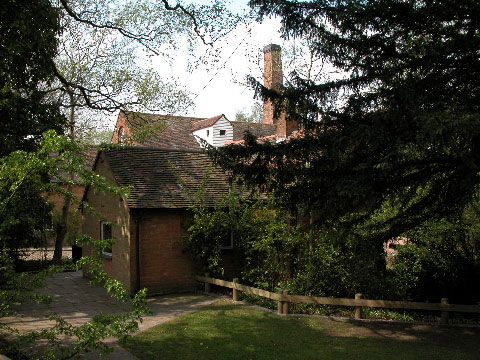
And so, we bid the Old Mill a fond
farewell, and set out from Hobbiton on the road to the Old Forest…
The Old Forest
- or, Moseley Bog
‘Looking ahead they could see only tree-trunks of innumerable sizes
and shapes: straight or bent, twisted, leaning, squat or slender, smooth or gnarled
and branched; and all the stems were green or grey with moss and slimy, shaggy
growths’.
Leaving the Old Mill, turn left through the car park and across the stream,
returning through the field to where you began in Wake Green Road. Find a safe
place to cross the busy road here, young Hobbit, and enter Thirlmere Drive, to
the left of No. 264. From here, walk until you reach Pensby Close and turn right
into this 1960’s community housing development., then bear left.
At the end of Pensby Close is a grassy area, cross this, and just by a set
of galvanised handrails you will see where the Coldbath Brook leaves Moseley Bog
and travels underground to the Mill Pond. It is here that we enter The Old Forest,
so beware, for you may not be alone…
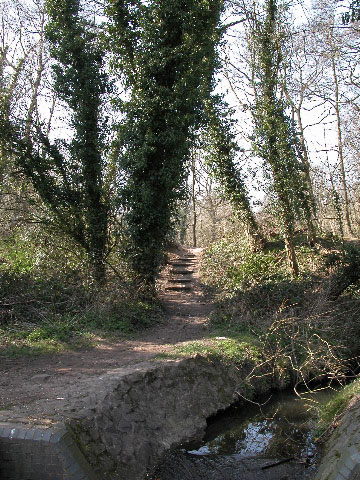
The entrance to Moseley Bog
Moseley Bog, now a wonderful nature reserve, is in fact the drained former
secondary storage pool for Sarehole Mill. Some 150 years ago, the water was drained
away, but the area never really dried out, and so by the late 1890’s this
had become a wooded dell, full of flowers. Today it preserves a little of that
lost rural Sarehole which has survived to the present day.
Entering the Bog and climbing over the bank, which was formerly a dam, turn
right along the top of the dam. Now you have truly entered the Old Forest. As
you wander further into the woods, you can see the remains of some of the brickwork
for the sluicegate that controlled the water flowing down to the Mill. With the
ivy-shrouded trees closing in around you, the world of the 21st century begins
to fade away, and the secretive rustling of leaves is interrupted only by birdsong
and the occasional furtive noise of some small animal in the undergrowth.
Follow the high ridge along the bank of the old dam, and then a walkway made
from old railway sleepers will lead you ever on and on through mature trees, until
a clearing beckons.
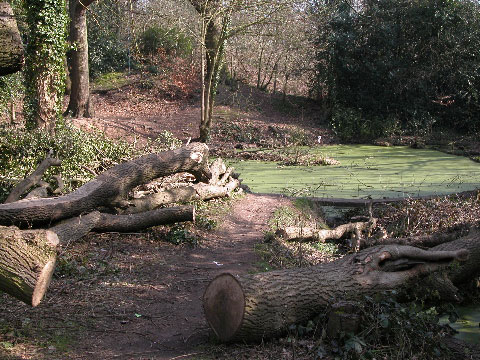
Smaug the Dragon and the slimy pond…
Quietly, you may enter. But beware, today this is the last refuge of Smaug
the Dragon – exercise caution, here! I find a gift of gold always quiets
his nerves, and who knows, he may let you rest awhile upon his back while you
eat a packed lunch. Careful, though, or you may be on the menu instead! I often
rest here a while, to read, and to dream…
Here also is a mysterious green pond, much beloved of TV producers making
programmes about Tolkien. Did the Tolkien boys play around this pool? We cannot
know for sure…
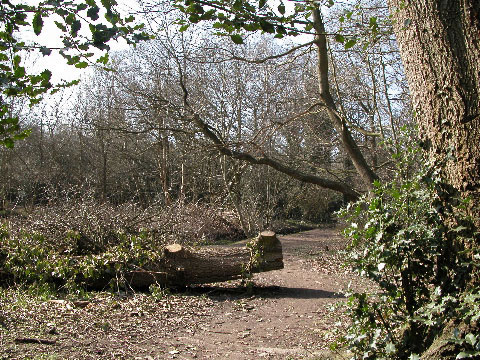
A path of quiet beauty
Having eaten your fill of food or of the clear air of Middle earth –
or having been chased away by Smaug (!) - continue on into the Old Forest.. Follow
the path, sometimes the sleeper walkway will be your guide, sometimes not. Work
your way cautiously around to the right, and then bear left through sylvan glades
and wooded dells, filled with seasonal bluebells, buttercups and glorious greenery.
The Old Forest is a strange and beautiful place, but it can be a little unnerving
if you enter it alone, gentle reader…

A way out
After a while, following the path as it curves to the left, you will see a
flight of steps that will take you out of the Bog and into Joy’s Wood, but
let us leave that for another day, and continue on our quest.
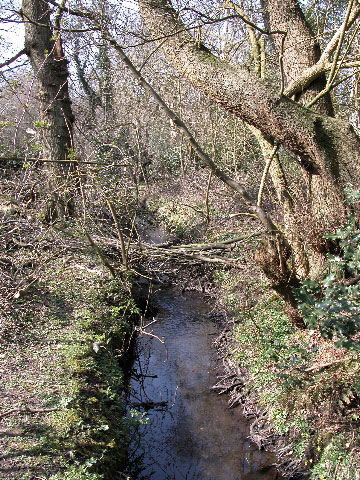
The Brook
You may now return whence you came, young Hobbit, walking in dappled shade
along the tinkling brook, the gently flowing water sounding like Elvish bells
or quiet voices floating on the breeze, as they make their way through the Forest
to the Grey Havens. Hark now, do you hear their sad lament for days long past?
The path will bring you back along the walkway, over the bridge and to the
dam, where you may if you wish return to the noisy 21st century, treading back
down Pensby Close and Thirlmere Drive to Wake Green Road.
But perhaps, gentle reader, you will tarry a while in the land of Middle Earth
and glimpse a little of the Fellowship of the Ring, before we seek out The Two
Towers? Come, just a little further along the road…
Strange Sights of Middle Earth
“The Road goes ever on and on
Down from the door where it began.
Now far ahead the Road has gone,
And I must follow if I can,
Pursuing it with eager feet,
Until it joins some larger way
Where many paths and errands meet.
And whither then? I cannot say.”
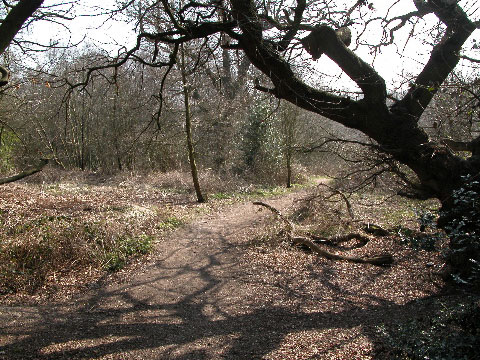
The road goes ever on and on
Step warily, friend, we know not what lies around the corner.

A clearing beckons
Carefully, now.
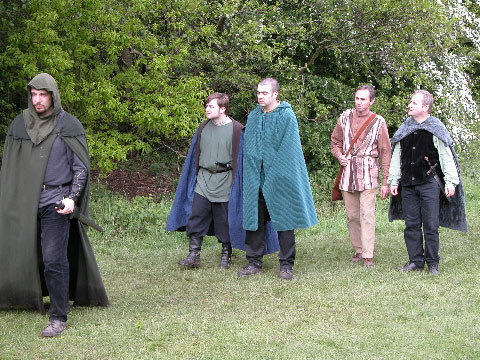
The Fellowship of the Ring approaches
Quick, hide behind that tree, and pull your cloak tight around
you, for we must not be seen.
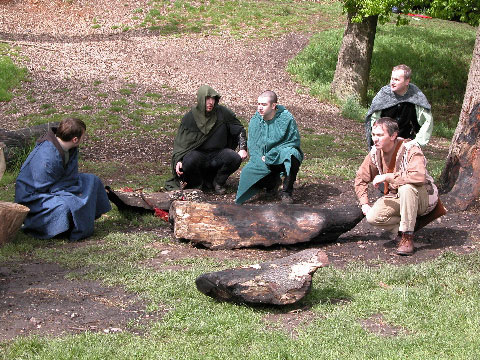
The Fellowship makes camp on Weathertop
I feel a great sense of foreboding.
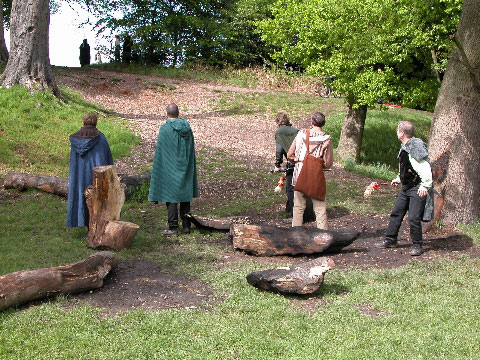
Dark figures on the horizon
Save us! Black Riders!
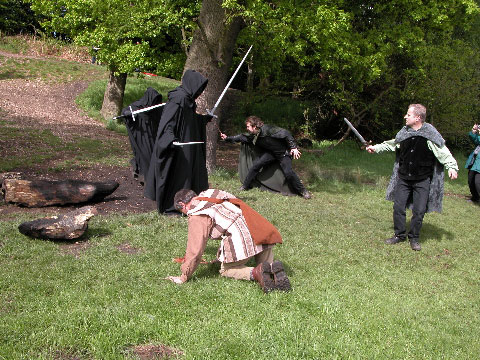
The Ringwraiths attack
Beware, their dark swords spell doom!
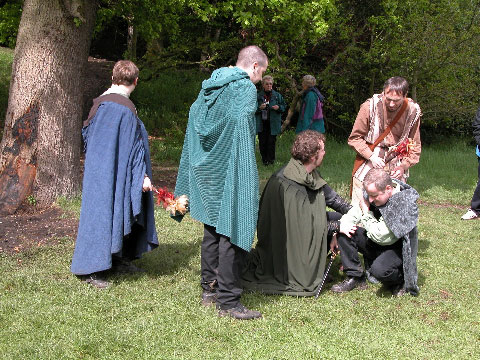
A Knife in the Dark
No! I would we could stay and help, but we cannot interfere with
the story. Frodo must make his own way, it is his destiny, and that of the Fellowship,
written in a greater book than ours. But hold – we may glimpse a little
more of their adventures…

The Mirror of Galadriel

‘I pass the test’, she
said. ‘I will diminish and go into the West, and remain Galadriel’.
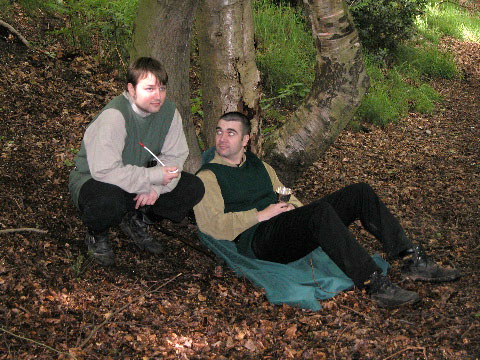
Merry and Pippin relax on the trail
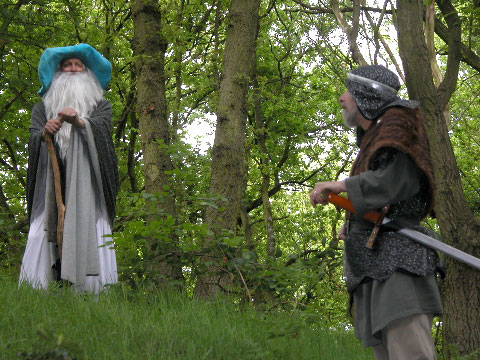
Gandalf and Theoden King
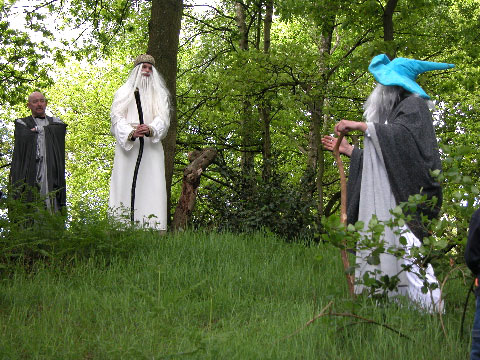
Gandalf confronts Grima Wormtongue
and Saruman
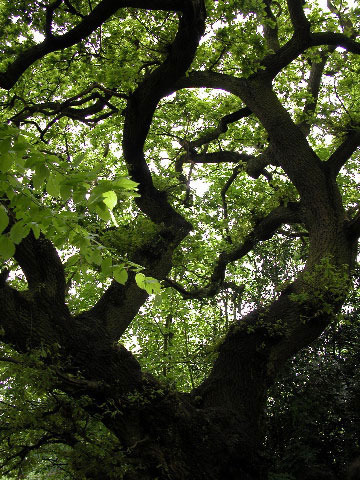
Treebeard considers a cautious reply
And so we leave the Old Forest, and continue on our quest, gentle
reader, this time to The Two Towers of Gondor.
The Two Towers and One Rediscovered

Approaching The Two Towers
Having left the Old Forest, to visit The Two Towers, young Hobbit,
you must travel back into the centre of Birmingham, and continue your quest from
there. It is simplest to then take a bus from near St. Philip’s Cathedral
in Colmore Row. Any bus travelling past Five Ways and along Hagley Road will suit.
Get off the bus in Hagley Road at the second stop after Five Ways traffic island
(first stop after the Edgbaston Shopping Centre), and you will see a little way
ahead and across the road an ancient public house called ‘The Plough and
Harrow’, on the corner of Plough and Harrow Road. Walk along Hagley Road
and cross safely at the traffic lights.
Enter Plough and Harrow Road and walk steadily until you reach
Waterworks Road. Here you enter the vicinity of Ladywood, and will see The Two
Towers looming ahead. It was here, on Stirling Road in fact, that Tolkien lived
during his later childhood and teenage years.
I have always found the natives friendly here, but it pays to
be cautious, young Hobbit, as this is now a run-down area attempting to regenerate
itself, and as with many such areas, crime has been a problem. Walk with fellow
travellers, if you can, and be cautious – you never know when an Orc might
appear…
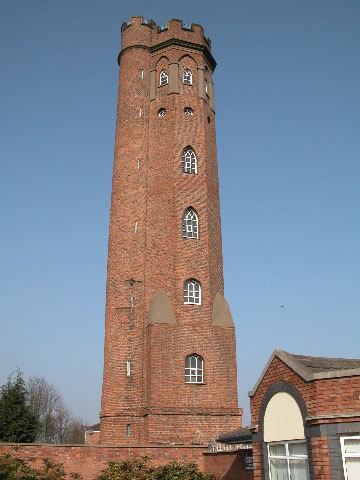
Minas Anor (Minas Tirith) – Perrott’s Folly
Literally just around the corner from Tolkien’s childhood
home in Sterling Road, and on Waterworks Road itself, you will find Perrott’s
Folly, a magnificent 18th century tower of brick and stone.
It is believed that Perrott’s Folly inspired the City of
Minas Anor in Gondor, later named Minas Tirith. Though the fictional Minas Tirith
is far more elaborate, it is understandable how inspiring the young Tolkien must
have found this remarkable building – I have always found it so!
This fabulous tower was built in 1758 by John Perrott, and stands
some 96 feet (30m) high. A Hobbit-sized door some 3ft (0.9m) high allows access
to the roof.
Perrott’s Folly may have been built as a hunting lodge
– when it was constructed, the tower was well out into the countryside,
and commanded dramatic views of the surrounding landscape, a great place for Perrott
to entertain his friends.
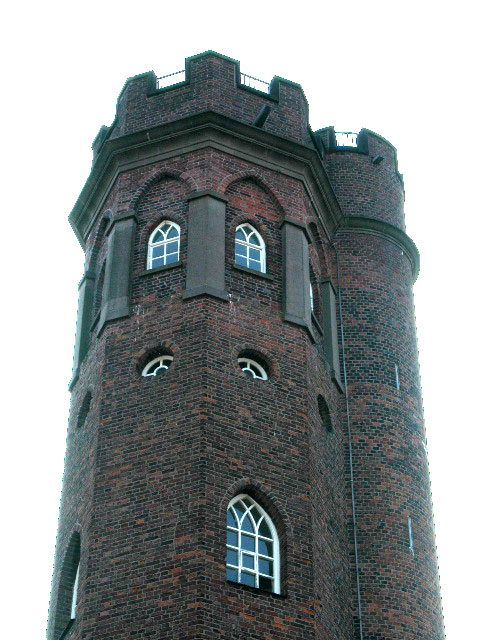
Top of the World, Ma
Between 1885 - 1979, the roof and topmost room of the Perrott’s
Folly was used as a meteorological observatory, first by the Birmingham &
Midland Institute and later by Birmingham University. It specialised mainly in
wind and sunshine observations following the establishment of a further weather
station at the nearby Edgbaston Reservoir in 1886 for measurement of temperature
and rainfall.
Today, the weather observatory resides at Birmingham University,
and the tower, which is not normally open to the public except for occasional
open days, is cared for by a charitable trust, The Perrott’s Folly Company.
The trust runs a group, the ‘Friends of Perrott’s
Folly’, with annual membership of £10 and life membership of £100,
and administers an appeal for the restoration and maintenance of the tower (all
payments in Sterling, cheques drawn on a UK bank and payable to Perrott’s
Folly Company). For further details, contact: Ian Cox, 52 Harborne Road, Edgbaston,
Birmingham, B15 3HE, United Kingdom.
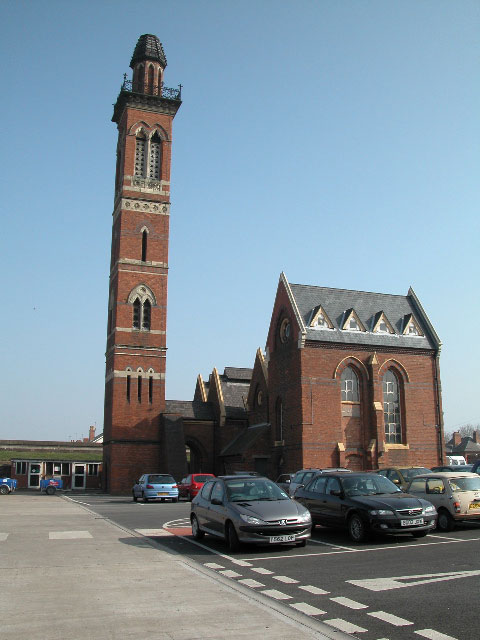
Minas Ithil (Minas Morgul) –
Edgbaston Waterworks
Walk on, young Hobbit, and you will discover the second tower
that Tolkien would have seen – and heard – near his home in Sterling
Road: the glorious Victorian Italianate tower of Edgbaston Waterworks, now under
the authority of Severn Trent Water Ltd.
Strictly speaking this is a highly decorated chimney, not a tower
– but what a chimney! This tower is thought to have inspired the fictional
creation of Minas Ithil, later to be named Minas Morgul when it became the home
of the Witch King and the evil Ringwraiths or Black Riders.
Built in 1862 and designed by architect J.H. Chamberlain, this
altogether more sinister looking tower is in fact the Grade II listed chimney
for the boiler house feeding a group of three steam engines which for many years
pumped water for Birmingham and Aston, extracting it from underground boreholes.
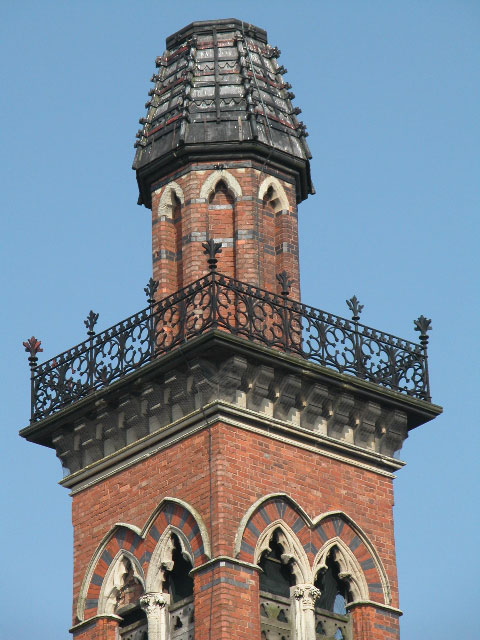
Atop the tower
The ageing steam engines were taken out of service in 1940, but
the young Tolkien’s view of this chimney in the early 1900’s would
have left a grim image of thick black smoke billowing up into the sky, and the
sound of multiple steam engines pumping all day long would have throbbed through
the surrounding area.
The continuous hurrying to and fro of men and horses delivering
coal, and the sunlit flash of spinning brass machinery through the windows of
the engine house would most certainly have completed a scene of brutal industrial
power that would have lodged firmly in the memory of a boy who had been moved
from the gentle English countryside to the harsh brick and cobbled reality of
industrial Birmingham. Now wonder he developed an aversion to industrial development!
Today, the Waterworks site is equipped with electric pumps that
distribute water from Frankley reservoir to other local reservoirs, and the tower
stands silent. It is possible to obtain a good view and take photographs from
the entrance and another gate, but visitors are not allowed on site due to insurance
problems.
We have one final tower to visit before we depart the childhood
haunts of J.R.R. Tolkien in Birmingham: Orthanc, the Tower of Saruman the White.
Dare you approach it with me, young Hobbit?
Orthanc Rediscovered
‘Beneath the mountain’s arm within the Wizard’s
Vale through years uncounted had stood that ancient place that Men called Isengard…
…This was its fashion, while Saruman was at his height,
accounted by many the chief of wizards. A great ring-wall of stone, like towering
cliffs, from which it ran and then returned again. One entrance only was there
made in it, a great arch delved in the southern wall…
…To the centre all the roads ran between their chains.
There stood a tower of marvellous shape. It was fashioned by the builders of old,
who smoothed the Ring of Isengard, and yet it seemed a thing not made by the craft
of Men, but riven from the bones of the earth in the ancient torment of the hills.
A peak and isle of rock it was, black and gleaming hard: four mighty piers of
many-sided stone were welded into one, but near the summit they opened into gaping
horns, their pinnacles sharp as the points of spears, keen-edged as knives. Between
them was a narrow space, and there upon a floor of polished stone, written with
strange signs, a man might stand a hundred feet above the plain. This was Orthanc,
the citadel of Saruman…’
There are more towers than two in The Two Towers, gentle reader!
Orthanc, headquarters of the corrupt wizard Saruman, stands tall and sinister
in the story and, together with Barad-dur, takes pride of place in the movie version.
The dark tower of Sauron will feature in my next article on the origins of the
land of Mordor, so I will say no more of it here, but where to find the inspiration
for Orthanc? Come, let me show you…
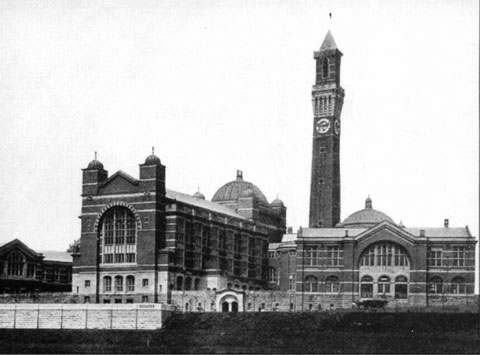
Orthanc - Birmingham University and
the Clock Tower, around the time of the First World War (1914 – 18)
Strangely, the real Orthanc most likely at the centre of a seat
of learning too – not wizardly, but another kind of magic altogether: science!
It is almost certain that the young Tolkien was familiar with the great early
buildings of Birmingham University; he apparently walked in a nearby park, and
the whole complex is not all that far from his home in Sterling Road.
By 1902, the buildings shown in this photograph were well under
construction, and is it so strange to believe that Ronald’s imagination
may have been later inspired to see in the growing circle of buildings ‘A
great ring-wall of stone, like towering cliffs’?
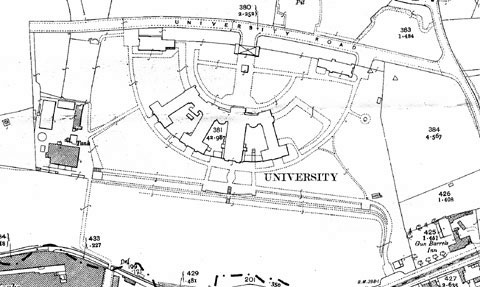
Birmingham University under construction,
Ordnance Survey 1902
The glorious red-brick complex that today forms the core of the
modern University was formally opened by King Edward VII in 1909. The dominant
feature at its centre is the remarkably familiar Chamberlain Clock tower –
fondly known as ‘Old Joe’ – which was designed to resemble the
14th century Torre del Mangia at Siena. Is this Orthanc? My heart tells me it
is so, and every time I see it I expect to find Saruman leaning down from its
peak, and a little shiver travels up my spine.
Visit Orthanc if you dare, my friend; it is most easily reached
by train to the University station from Birmingham New Street Station. Full directions
are at:
http://www.location.bham.ac.uk/directions.htm
And when you visit, why not also enjoy the University’s
nearby on-campus Lapworth Museum of Geology, a fabulous feast of fossils and minerals
– details at: http://www.earthsciences.bham.ac.uk/museum/
So ends our tour of Tolkien’s childhood haunts and inspirations
in Birmingham. In my next article, we conclude our quest in the dark heart of
The Black Country – The Land of Mordor, where the shadows lie…
|